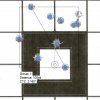A few things wrong in your explanation Ian. First, not half of my "handguns" are large caliber slow twist. Many are bottle neck rifle cartridges in XP's, Contenders and others up to and including 308 Winchester or 30 caliber revolver, others including 6.5 TCU, 7 TCU, 30 TCU, 6.5 BR, 7 BR, 30 BR & more (I never did run cast in the 6 BR). Next I doubt you'll find many people that have done as much heat treating and heat treating experimenting as I have, have you read the articles I published on this? I'm also sure you've seen my posts on the result of crimp/neck tension testing, if not I could re-post it here. Yes, I shot handgun silhouette for 30 plus years using most of those cartridges.
I said in posts #14 & #16 in this thread that I haven't experimented with very low velocity using very fast powder or experimented with high velocity in rifles and that I wasn't talking to or about either. All that said probably 95%+ of cast bullet shooting/shooters is done within the parameters I mentioned, 800 fps up through 2,000 fps in numerous calibers, velocities, pressures, bullet weight/styles, action types etc. Not yet have I experienced the problems using tin that you mention.
Not likely that I will delve into the rifle high velocity testing, when that first came up on the CB forum it peaked my interest and I intended to, sounded interesting but it so rapidly turned into pure BS it squeezed all desire and interest right out of me and I dropped all thought of it.
I said in posts #14 & #16 in this thread that I haven't experimented with very low velocity using very fast powder or experimented with high velocity in rifles and that I wasn't talking to or about either. All that said probably 95%+ of cast bullet shooting/shooters is done within the parameters I mentioned, 800 fps up through 2,000 fps in numerous calibers, velocities, pressures, bullet weight/styles, action types etc. Not yet have I experienced the problems using tin that you mention.
Not likely that I will delve into the rifle high velocity testing, when that first came up on the CB forum it peaked my interest and I intended to, sounded interesting but it so rapidly turned into pure BS it squeezed all desire and interest right out of me and I dropped all thought of it.








